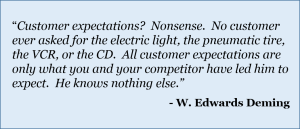One of the biggest problems companies have that interferes with long-term success is variation in people, team, and leadership styles throughout the organization. This variation wreaks havoc with the company’s culture and leads to a host of problems that directly and indirectly affects performance.
An organization’s hiring process contributes directly to variation in personality, values, and leadership style. In most companies, the hiring decision is made by the manager to whom the person will ultimately report which often leads to hiring people who are a fit for the manager’s style rather than the style of the organization. The manager also has a need that, depending on the pressure to fill that need quickly, may drive the decision to hire someone without proper consideration to alignment of the person’s personality and values to those of the organization.
This sounds like an exaggeration but it is something that happens every day in many companies. Unless the organization has a clear idea of its desired culture and the DNA of its people, and has a method to screen candidates to assure a proper match, its chances of creating the desired culture are very small.
Let Human Resources Do It
Giving human resources the power to make the hiring decisions is not a very popular viewpoint. People complain that the HR team does not have the knowledge to hire the right person and is too disconnected to the workplace to effectively carry out the process. When looked at in light of the long-term cultural ramifications, however, centralizing the hiring process within the HR team begins to make sense. Some of the reasons for this include:
- They touch all areas of the company and have a better understanding of the overall system than someone whose work is limited to a specific function;
- Having an independent team handling hiring ensures consistency across the organization. They can make sure that the decision is based on competency as well as a fit to the company’s culture, which can reduce the hiring of friends or making a quick decision because of an immediate need;
- It puts the responsibility of protecting the company DNA in one area that can continually close gaps in attempting to hire the perfect employee;
- Like any process, the more hiring is handled by one team, the better they will get at performing the process. When hiring is decentralized, managers across the company do it so seldom that they never really get good at it.
There are obviously some basic elements that enable a centralized hiring process to work effectively. First and foremost, human resource professionals need to spend a significant amount of time at gemba connecting with teams and working to understand the problems the teams face on a daily basis. One way to help this is to rotate team members into human resources assignments on a regular basis. Doing this will help HR better understand the areas they serve as well as having those served to understand human resource systems and methods.
Another important requirement to ensure the success of the process includes having a clear definition of the organization’s DNA and an understanding of how well the process is performing in terms of screening candidates for the DNA.
Finally, centralizing the hiring decisions within the human resource function requires HR team members to be responsive to the needs of its customers. Although it may take time to find the right candidates, the process must continue to move until the position is filled.
I am not a human resource professional but having faced the numerous problems caused by variation in the hiring process, I’ve come to the conclusion that centralizing it is the best approach for most organizations. If culture is truly valued as critical to long-term performance, we should always be looking for better ways to create it in a way that provides a true competitive advantage. The hiring process has such a large impact on culture that it is a logical place to begin looking to understand whether it helps or hurts the company’s efforts to improve.





